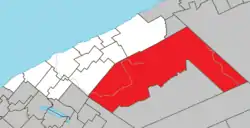Rivière-Bonjour, Quebec
Rivière-Bonjour is an unorganized territory in the Bas-Saint-Laurent region of Quebec, Canada. A large part of the territory is part of the Matane Wildlife Reserve.
Rivière-Bonjour | |
|---|---|
 | |
 Location within La Matanie RCM. | |
 Rivière-Bonjour Location in eastern Quebec. | |
| Coordinates: 48°46′N 66°55′W[1] | |
| Country | |
| Province | |
| Region | Bas-Saint-Laurent |
| RCM | La Matanie |
| Constituted | January 1, 1986 |
| Government | |
| • Federal riding | Haute-Gaspésie—La Mitis—Matane—Matapédia |
| • Prov. riding | Matane-Matapédia |
| Area | |
| • Total | 1,679.50 km2 (648.46 sq mi) |
| • Land | 1,682.50 km2 (649.62 sq mi) |
| There is an apparent contradiction between two authoritative sources | |
| Population | |
| • Total | 16 |
| • Density | 0.0/km2 (0/sq mi) |
| • Pop 2016-2021 | |
| • Dwellings | 67 |
| Time zone | UTC-5 (EST) |
| • Summer (DST) | UTC-4 (EDT) |
| Area code(s) | 418 and 581 |
| Highways | |
The eponymous Bonjour River is a 15 kilometres (9.3 mi) long stream roughly in the centre of the territory that has its source at the south-eastern slopes of the Chic-Choc Mountains, including the 1,065 metres (3,494 ft) high Mont Blanc. The stream joins the Matane River at Matane Lake.[4]
Demographics
Population
Canada census – Rivière-Bonjour community profile
| 2021 | 2011 | |
|---|---|---|
| Population | 16 (+0.0% from 2016) | 10 (-33.3% from 2006) |
| Land area | 1,682.50 km2 (649.62 sq mi) | 1,681.79 km2 (649.34 sq mi) |
| Population density | 0/km2 (0/sq mi) | 0.0/km2 (0/sq mi) |
| Median age | 0 (M: 0, F: 0) | N/A (M: , F: ) |
| Private dwellings | 0 (total) | 145 (total) |
| Median household income | $.N/A |
|
|
|
|
.JPG.webp)
Lake Matane in the Matane Wildlife Reserve
References
- "Reference number 149686 in Banque de noms de lieux du Québec". toponymie.gouv.qc.ca (in French). Commission de toponymie du Québec.
- "Rivière-Bonjour". Répertoire des municipalités (in French). Ministère des Affaires municipales, des Régions et de l'Occupation du territoire. Retrieved 2012-01-17.
- "Profile table, Census Profile, 2021 Census of Population - Rivière-Bonjour, Unorganized (NO) [Census subdivision], Quebec". 9 February 2022.
- "Rivière Bonjour" (in French). Commission de toponymie du Québec. Retrieved 2012-01-24.
- "2021 Community Profiles". 2021 Canadian Census. Statistics Canada. February 4, 2022. Retrieved 2022-04-27.
- "2011 Community Profiles". 2011 Canadian Census. Statistics Canada. March 21, 2019. Retrieved 2014-02-08.
- "2006 Community Profiles". 2006 Canadian Census. Statistics Canada. August 20, 2019.
- "2001 Community Profiles". 2001 Canadian Census. Statistics Canada. July 18, 2021.
- Statistics Canada: 1996, 2001, 2006, 2011, 2016, 2021 census
This article is issued from Wikipedia. The text is licensed under Creative Commons - Attribution - Sharealike. Additional terms may apply for the media files.